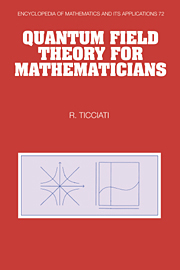Book contents
- Frontmatter
- Contents
- Preface
- Introduction
- 1 Relativistic Quantum Mechanics
- 2 Fock Space, the Scalar Field, and Canonical Quantization
- 3 Symmetries and Conservation Laws
- 4 From Dyson's Formula to Feynman Rules
- 5 Differential Transition Probabilities and Predictions
- 6 Representations of the Lorentz Group
- 7 Two-Component Spinor Fields
- 8 Four-Component Spinor Fields
- 9 Vector Fields and Gauge Invariance
- 10 Reformulating Scattering Theory
- 11 Functional Integral Quantization
- 12 Quantization of Gauge Theories
- 13 Anomalies and Vacua in Gauge Theories
- 14 SU(3) Representation Theory
- 15 The Structure of the Standard Model
- 16 Hadrons, Flavor Symmetry, and Nucleon-Pion Interactions
- 17 Tree-Level Applications of the Standard Model
- 18 Regularization and Renormalization
- 19 Renormalization of QED: Three Primitive Divergences
- 20 Renormalization and Preservation of Symmetries
- 21 The Renormalization Group Equations
- Appendix
- References
- Index
13 - Anomalies and Vacua in Gauge Theories
Published online by Cambridge University Press: 31 October 2009
- Frontmatter
- Contents
- Preface
- Introduction
- 1 Relativistic Quantum Mechanics
- 2 Fock Space, the Scalar Field, and Canonical Quantization
- 3 Symmetries and Conservation Laws
- 4 From Dyson's Formula to Feynman Rules
- 5 Differential Transition Probabilities and Predictions
- 6 Representations of the Lorentz Group
- 7 Two-Component Spinor Fields
- 8 Four-Component Spinor Fields
- 9 Vector Fields and Gauge Invariance
- 10 Reformulating Scattering Theory
- 11 Functional Integral Quantization
- 12 Quantization of Gauge Theories
- 13 Anomalies and Vacua in Gauge Theories
- 14 SU(3) Representation Theory
- 15 The Structure of the Standard Model
- 16 Hadrons, Flavor Symmetry, and Nucleon-Pion Interactions
- 17 Tree-Level Applications of the Standard Model
- 18 Regularization and Renormalization
- 19 Renormalization of QED: Three Primitive Divergences
- 20 Renormalization and Preservation of Symmetries
- 21 The Renormalization Group Equations
- Appendix
- References
- Index
Summary
Completing the presentation of quantization of gauge theories with an investigation into the possibility that quantum effects might cause a classical conservation law to break down and thereby render the Faddeev—Popov procedure inapplicable.
Introduction
The logic of the gauge principle, the simplicity of the Faddeev—Popov principle, and the absence of any competing means for constructing quantum field theories with non-abelian symmetries have together made the constructions of the previous chapter central to high-energy model building. Therefore, in this chapter, we pursue the analysis of gauge theories a little further.
Gauge invariance of a classical field theory does not imply gauge invariance of the corresponding quantum field theory. Invariance under gauge transformations is tested in two stages: first, infinitesimal gauge transformations, and second, finite gauge transformations. Of course, invariance under infinitesimal gauge transformations implies invariance under all exponentials of infinitesimal gauge transformations, but there may be gauge transformations that are not of this form. Hence the need for two steps.
A classical symmetry which does not survive quantization is said to be anomalous. When infinitesimal gauge symmetries are anomalous, then the quantum theory is inconsistent. But the finite gauge symmetries can be anomalous without making the quantum theory inconsistent.
The opening sections, Sections 13.1 to 13.5 discuss the first or local level of gauge invariance and clarify the relation between classical equations of motion and conservation laws and their quantum counterparts.
- Type
- Chapter
- Information
- Quantum Field Theory for Mathematicians , pp. 412 - 437Publisher: Cambridge University PressPrint publication year: 1999



